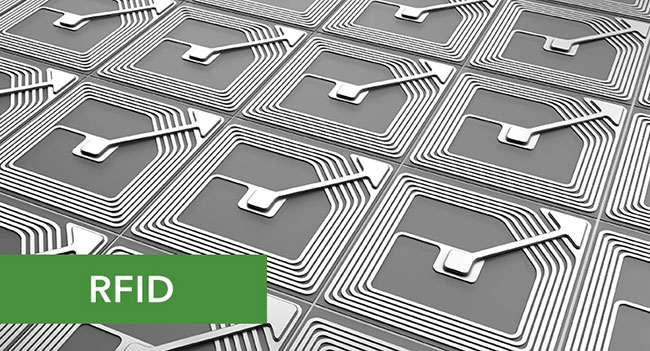Difference between NFC and RFID
There seems to be some confusion between the two technologies RFID and NFC. Although they are similar in many ways, there are some differences between the two technologies. Let's find out the difference between NFC and RFID through the following article!
How is NFC different from RFID?
There are many similarities between RFID and NFC, but there are also some sharp contrasts. The main difference between these two technologies is the range of information collected.
- Near Field Communication (NFC) only has a range of about 4cm (in most cases phones).
- Radio Frequency Identification (RFID) uses radio waves and antennas to help expand the range that data can be read. RFID also has two types of tags - passive and active.
Are there any power requirements that differ between the two technologies?
Have. NFC uses power from the phone to read data embedded in tags or labels. RFID tags can be passive or proactive as outlined above. This means that RFID tags will use energy to transmit data.
For systems that read data from both the NFC tag and the RFID tag, RFID will use a bit more power, because they are running the antenna system and depending on how the RFID system is set up, setting Being constantly read and tagged with data transfers will increase the energy usage of this system.
 RFID
RFID Is there a cost difference between NFC and RFID?
Yes, NFC is usually a cheaper solution, since there is no additional technology if you use them for advertising or customer information (the cost of the reader is in the customer's phone).
On the other hand, RFID can be a complete tracking solution for assets, tools, shipping containers, etc. This is a case where the range of RFID tags and tags is diverse. For example, active RFID labels encased in plastic, metal or hard rubber covers can range from $ 4 to $ 20, depending on its variants. This means that these types of tags are often used to track high-cost items, such as shipping containers, machines and tools, etc.
Is there a difference in storage capacity between NFC and RFID?
This is not really a question to ask, as RFID and NFC have two very different uses. RFID tags will usually store the tracking number or serial number, allowing you to track individual products with their unique code. This is the case where a large amount of storage is required in tags.
Is NFC or RFID more secure?
Given the nature of the information stored in the RFID tag, they may be a more secure option, because if someone can hack and collect or change the tag's information, they actually only change some of it. SKU (inventory tracking number). While this can be a problem for businesses, it's not a big deal.
On the other hand, NFC tags can easily be reprogrammed, if they are not properly written, i.e. if you find a smart poster or product where the tag is not set to Read-only, you This tag can be overwritten with an NFC writing application, such as NFC Easiwayv Tools.
 NFC only has a range of about 4cm
NFC only has a range of about 4cm How is the data transfer rate of NFC and RFID different?
Again, this is not really the question to be asked. NFC data is transmitted almost instantly thanks to the short range, and if the active RFID tag is hundreds of meters away, it may take a bit longer for the data to reach the reader.
How does range on NFC compare to RFID?
This is where RFID really comes in. RFID tags have their own power source, meaning their range can reach 100 meters and more. While NFC only has a range of about 4cm.
Depending on the frequency of the RFID system used, this will affect its range. Here are some approximate ranges for different frequencies in RFID.
- Low frequency (125-134kHz) - Up to 10cm
- High frequency (13.56mHz) - Up to 30cm
- Ultra high frequency (856mHz to 960mHz) - Up to 100m
You should read it
- Wireless technology for managing people and objects - Future social networks?
- 8 technology-related obsessions of the decade
- Differentiate between TTF and OTF fonts
- What is a worksheet? Differentiate between Worksheet and Workbook
- Differentiate Windows 8 Pro and Windows RT
- Differentiate Apple ID and iCloud
- What is the difference between Hex, RGB and HSL?
- What is the difference between GUI and CLI?
May be interested
- Difference between Ethernet and LAN
 ethernet and lan are closely related, in that ethernet is the main technology that makes the concept of lan become reality. the main difference between ethernet and lan is that the operation of ethernet is decentralized, while lan is the opposite.
ethernet and lan are closely related, in that ethernet is the main technology that makes the concept of lan become reality. the main difference between ethernet and lan is that the operation of ethernet is decentralized, while lan is the opposite. - Difference between LAN, MAN and WAN
 the network allows computers to connect and communicate with other computers through any means. lan, man and wan are three types of networks designed to operate on the area they cover. there are several similarities and differences between them.
the network allows computers to connect and communicate with other computers through any means. lan, man and wan are three types of networks designed to operate on the area they cover. there are several similarities and differences between them. - Difference between GDDR RAM and RAM
 gddr ram and system ram are common terms that you will come across in the desktop world. while these terms may seem similar and interchangeable, they are not.
gddr ram and system ram are common terms that you will come across in the desktop world. while these terms may seem similar and interchangeable, they are not. - Difference between Internet and Web
 what are the similarities and differences between the internet and the web? for those who understand information technology, these two concepts are no longer strange, but for those who are just starting to learn, they may not clearly understand the concept as well. their effects, the content below, taimienphi will show you the difference between the internet and the web.
what are the similarities and differences between the internet and the web? for those who understand information technology, these two concepts are no longer strange, but for those who are just starting to learn, they may not clearly understand the concept as well. their effects, the content below, taimienphi will show you the difference between the internet and the web. - Difference between NUC and SBC
 people often compare intel's next unit of computing (nuc) devices to single-board computers. the comparison is based on the fact that many people think that these two devices are more or less similar. although not completely unfounded, this assumption is false.
people often compare intel's next unit of computing (nuc) devices to single-board computers. the comparison is based on the fact that many people think that these two devices are more or less similar. although not completely unfounded, this assumption is false. - The difference between TCP and UDP protocols
 you may have seen tcp and udp when setting up port forwarding on the router or when configuring the firewall software. these two protocols are used for different data types.
you may have seen tcp and udp when setting up port forwarding on the router or when configuring the firewall software. these two protocols are used for different data types. - If you can find a difference in 10 seconds, you're really a genius!
 if you can find a difference in 10 seconds, you're really a genius! try fastness with 6 images below!
if you can find a difference in 10 seconds, you're really a genius! try fastness with 6 images below! - The difference between Sass and SCSS: Which CSS Preprocessor is right for you?
 the difference between sass and scss syntax is very difficult to detect. so, make sure you understand them before making a choice.
the difference between sass and scss syntax is very difficult to detect. so, make sure you understand them before making a choice. - The difference between the URL and the URI
 the terms uri and url are often used interchangeably, but they are not exactly the same. a url is a specific type of uri that provides a location / method of access.
the terms uri and url are often used interchangeably, but they are not exactly the same. a url is a specific type of uri that provides a location / method of access. - What is the difference between HDR and 4K?
 when buying a tv, the terms 4k and hdr may come across. both of these technologies improve image quality. however, they do this in very different ways.
when buying a tv, the terms 4k and hdr may come across. both of these technologies improve image quality. however, they do this in very different ways.










 What is SIM-jacking?
What is SIM-jacking? What is a RADIUS Server? How does RADIUS Server work?
What is a RADIUS Server? How does RADIUS Server work? What is web scraping? What is Web Scraping used for?
What is web scraping? What is Web Scraping used for? What is UI UX? Differences between UI and UX design
What is UI UX? Differences between UI and UX design What is CHD file? How to use CHD file?
What is CHD file? How to use CHD file? What is teraflop?
What is teraflop?